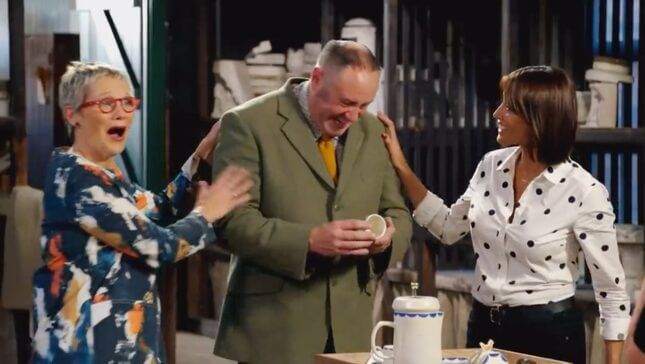The Great Pottery Throw Down Took My Lump of Clay Heart and Made Something Beautiful
EntertainmentTV

It is not often you will see a competition show host burst into tears at the mere sight of something beautiful, or watch as dozens of competitors and rivals huddle around a dear friend in need of some extra assistance. Thankfully, such occurrences are common on the Great Pottery Throw Down, a show I spent the past three months therapeutically crying to while watching. With its latest season now complete, I’ve signed myself up for pottery classes, desperate to feel as alive as I did seeing contestants pull teapot handles or pit-fire intricate Grecian statues.
Premised around pottery—obviously—the series is set in a 19th-century factory in Stoke-on-Trent, England, famous for its earthenware. Each week, judges put prospective potters through three rounds of challenges, some based on wheel-throwing the pottery, others on hand-building. The first and last are based around the “main make,” elaborate tests of the potters’ skills that usually result in breakfast sets or fireplaces. In between, while their pottery is being kiln-fired, they’re handed crushingly hard tests of endurances called “spot tests.” Whether it’s painting Victorian ceramics, or making 20 identical cups and plates, each is designed to push the limits of what the amateur artists are capable of.
Like its sister show, The Great British Bake Off, there is a sense of camaraderie that is baked—literally and figuratively—into the structure of the show. Frequently, competitors who hold a lead will abandon their designs to help each other out, especially when pottery bursts in the kiln or someone, unfortunately, drops their design while carrying it to the glazing station. Despite its obvious stakes as a competition show, its fabulous to sit and watch people with a genuine love for what they do, which fosters into kinship with other potters. There are no secrets among them, no hoarding of information or techniques. Petty jealousies premised around a cash prize are nonexistent—or at least, unspoken—and the judges, when they can, afford more leeway to accidents and missteps than I’ve ever seen on television.
And as far as the judges, there has never been a more electric pair than Keith Brymer Jones and Sue Pryke. Where he will spontaneously burst into tears when feeling particularly proud of any given competitor, Pryke brings gravitas and wisdom that is greatly needed for art as mystifying to me as pottery. Host Melanie Sykes, meanwhile, is simply fantastic. She lights up the television screen, laughing and prancing about the pottery, occasionally looking on in sheer terror as potters carry 20 pounds of delicate clay across the studio. And besides that, she’s actually funny, a skill that is unsurprisingly rare among television hosts.
The below clip, during the final judging of this season’s first episode, showcases the brilliance of its format, as well as the alchemy between hosts, judges, and competitors alike. When Jones bursts into tears while congratulating fan-favorite Rosalind, Pryke and Syke’s immediately jump in to comfort him, and her, and together they all stand and marvel at the creation before them—a simple breakfast set.
My heart was once a lump of clay, but with his great, big, pottery worn hands, Keith Brymer Jones has slowly spun it into something beautiful. A teapot, perhaps, with little chickens painted on it!
Unlike its more popular sibling, which saw great success on Netflix and Twitter, Great Pottery Throw Down languished in development hell after being abruptly canceled by BBC on Channel 4. Because of this, there wasn’t much buzz around Season 3, nor is it currently available anywhere you’d find your fix of British competition shows. If you’re lucky enough to have an address in the U.K., you can stream all of Season 3 here. Otherwise, I suggest you google “Throw Down S03E01.” I’ll leave you to figure out the rest!